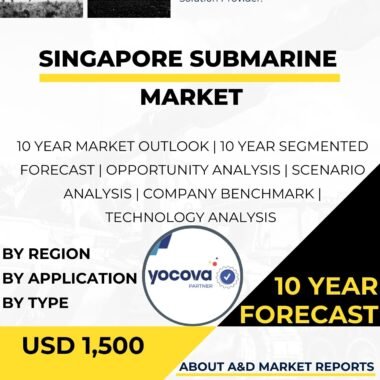Description
The submarine market in Japan has witnessed significant growth and strategic importance as the nation seeks to enhance its maritime security, deter potential threats, and protect its maritime interests. Submarines are critical assets for modern navies, offering stealth, mobility, and versatility in underwater operations. As an island nation with extensive territorial waters and a vast Exclusive Economic Zone (EEZ), Japan relies on its submarine fleet to safeguard its maritime borders, gather intelligence, and maintain deterrence against potential adversaries.
The submarine market in Japan encompasses a range of activities, including the construction, modernization, and support of submarines for the Japan Maritime Self-Defense Force (JMSDF). The JMSDF is responsible for safeguarding Japan’s maritime security and operates a fleet of submarines equipped with advanced technology and capabilities.
One of the primary applications of submarines in Japan is to enhance its maritime security and defense capabilities. Submarines offer a stealthy and covert means of patrolling Japan’s maritime borders, monitoring potential intrusions, and responding to security threats. These underwater platforms play a crucial role in countering potential naval threats and ensuring that Japan’s maritime interests are protected.
Moreover, submarines contribute significantly to Japan’s intelligence, surveillance, and reconnaissance (ISR) capabilities. Submarines equipped with sophisticated sensors and communication systems can gather critical intelligence in both littoral and open ocean environments. These submarines support the nation’s efforts in monitoring regional activities, gathering information on potential security threats, and maintaining situational awareness in the Pacific region.
Furthermore, submarines play a crucial role in enhancing Japan’s deterrence posture. As an advanced maritime power, Japan relies on its submarine fleet to deter potential adversaries and maintain stability in the region. The strategic deployment of submarines with advanced technology and capabilities contributes to Japan’s national security strategy and demonstrates its commitment to safeguarding its territorial waters and maritime interests.
As Japan emphasizes indigenous defense capabilities, the domestic construction and modernization of submarines have seen substantial growth. Collaborations between the government, defense industry, and research institutions have fostered innovation, leading to the creation of state-of-the-art submarines tailored to Japan’s specific defense requirements.
Japan’s alliance with the United States has also played a significant role in the development of its submarine capabilities. Through this partnership, Japan has access to advanced submarine technologies, expertise, and support, contributing to the modernization of its defense forces and enhancing interoperability with allied navies.
The submarine market in Japan also benefits from advancements in submarine technology, propulsion systems, and underwater warfare capabilities. Manufacturers have leveraged these developments to create submarines with improved stealth, endurance, and sensor integration, making them more effective in modern maritime operations.
However, the submarine market in Japan also faces challenges related to regional security dynamics, submarine technology proliferation, and budget constraints. Japan’s security environment is influenced by regional geopolitics, including potential threats from neighboring countries. Addressing these challenges requires continuous vigilance and readiness to respond to evolving security situations.
Moreover, the proliferation of submarine technology in the region poses challenges to Japan’s maritime security. As more countries acquire submarines, it becomes essential for Japan to enhance its submarine detection and anti-submarine warfare capabilities to counter potential underwater threats effectively.
Additionally, budget constraints can impact the procurement and modernization of submarines. Ensuring sufficient funding for submarine programs is crucial to maintaining the readiness and effectiveness of Japan’s submarine fleet.
In conclusion, the submarine market in Japan has witnessed significant growth and strategic importance, driven by the nation’s focus on enhancing its maritime security, ISR capabilities, and deterrence posture. Submarines provide critical solutions for maritime defense, intelligence gathering, and deterrence, catering to Japan’s specific maritime requirements. The collaboration between the government, defense industry, and research institutions, as well as international partnerships with allied nations, fosters innovation and contributes to the growth of the domestic submarine market. Addressing challenges related to regional security dynamics, submarine technology proliferation, and budget constraints is crucial for further enhancing Japan’s submarine capabilities and ensuring that its defense forces remain equipped with advanced and reliable submarines to effectively safeguard its maritime interests and contribute to regional stability. With its strategic focus on indigenous defense capabilities, Japan remains committed to leveraging advanced submarine technologies to enhance its maritime security and maritime operational capabilities in the Pacific region.




